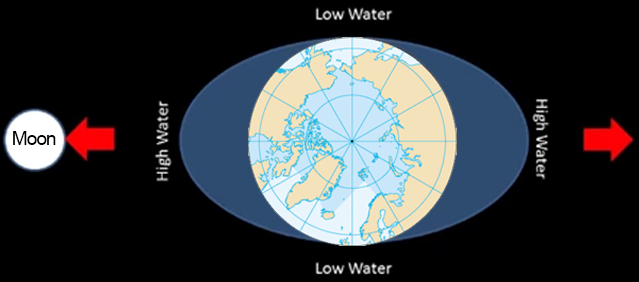Anyone who has been to a coast might have noticed that the edge of the ocean moves forward and backward depending on the time of the day. Sometimes it moves inland while at other times the water recedes into the sea. This phenomenon is called tides. What causes this change in the level of the seas and oceans? Simply put, it is the gravitational forces imparted by the Sun and the Moon and the Earth itself.
Earth has its own gravitational force. Additionally it rotates around its own axis. These two combined ensure that the levels of the seas are kept relatively stable around the Earth. The Moon then comes into play. The Moon's gravity is strong enough to "pull" water towards itself causing the water to bulge. This bulge moves in conjunction due to the Moon's orbiting the Earth and the Earth's rotation itself. When the effects are string enough, the water bulges and we experience high tide at some places, while at other places where the effect is not as strong we experience a low tide.
During its rotation around the Earth the Moon is at different locations with reference to the Sun. When the Sun, Earth and Moon line up in one straight line during either Full Moon or New Moon, the tidal effects are greater. These are known as spring tides, though have nothing to do with the season. Maybe the name comes from the fact that during these times the water springs higher than at other times.

When the Moon and the Sun are at 90° with reference to the Earth, during the First Quarter and Third Moon phases, the tides are not as high and are called neap tides.
Also, when the Moon is closer to Earth in its orbital plane, the effects of tides are greater.
Most commonly tides occur twice a day, or diurnally. There can, however, be two high tides and two low tides in a day, making it semi diurnal. And, the point of high tide is not the same each day since the Moon takes 50 minutes longer each day to come the same alignment with the Earth. Therefore, each tide starts 24 hours and 50 minutes later than the one previous to it.
High tide is marked by the high water mark while low tide is marked by the low water mark. The difference between the high water mark and the low water mark is called the tidal range. The time take between high water and low water is six hours.
Though it seems that calculations based on the Moon, the Sun and the Earth and their relative positions, it might be possible to predict tides with a certain amount of accuracy. However, that is not the case. Since are affected by local geography terrain, ocean topography, seabed contours, water depth, etc, each location that experiences tides has a unique chart as far as tides are concerned and an accurate prediction of tides at each location is based on looking at data over a number of years and drawing up a reasonably accurate tide chart.










Leave a Reply
You must be logged in to post a comment.